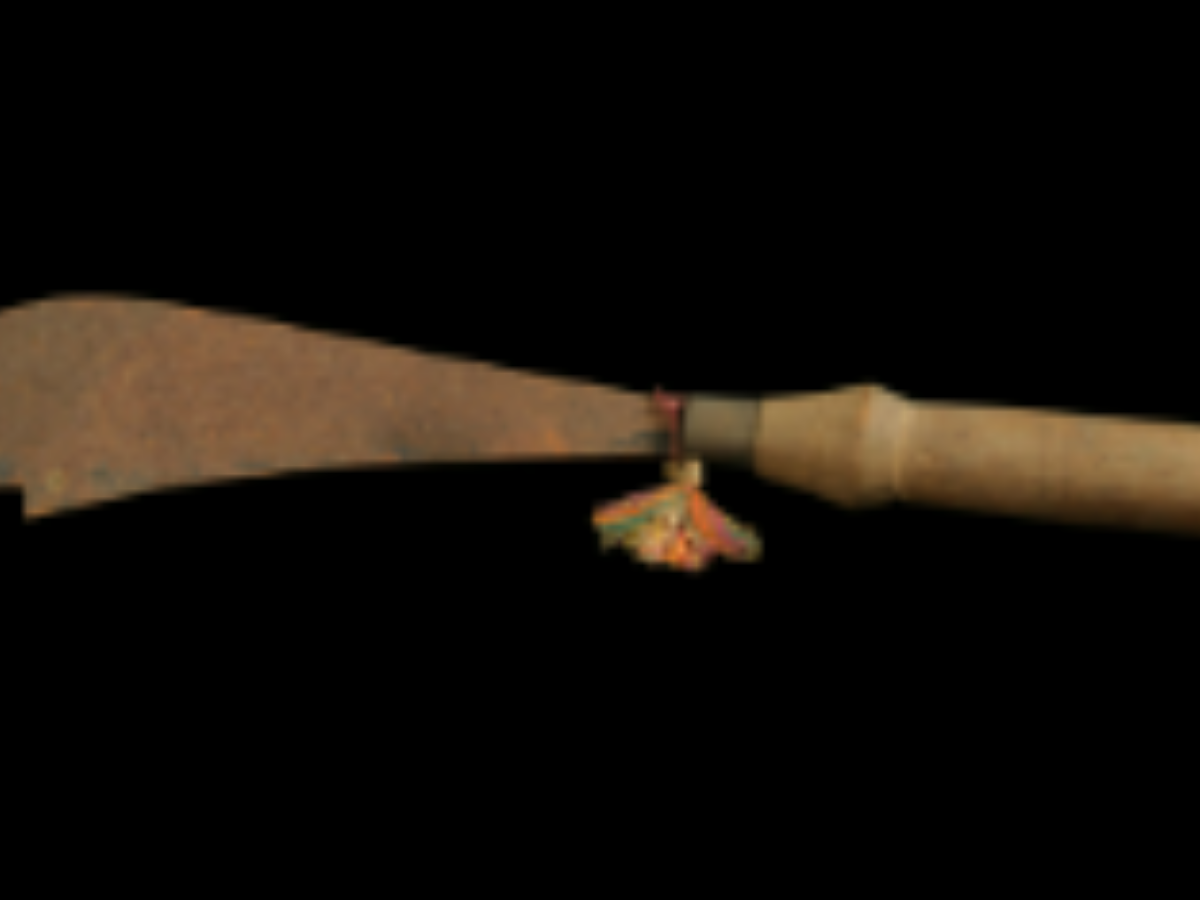State
Tribe Name
Art Type
short description
Kabui Naga, the native clan of Manipur and some parts of Nagaland, have always been reputed for their culture, warrior history, and fine artistic skills. Bhang-Chaku-one of the most symbolic weapons of Kabui Naga-is a traditional iron sword and more popularly refers to the "dancing sword."
The Bhang-Chaku sword is unique, as much for its symbolic and aesthetic connotation as for its use in warfare and ceremony. It features an acute curve for an iron blade with straight and slanting top edges. A middle projection on a blunt edge gives the sword its distinct visual character and also a bit of functional application. One face is adorned with engraved circular motifs that bear testimony to tribal artistry, while at the same time speaking of the sword's symbolic importance in initiatory and other cultural rituals.
The tang of the blade is securely mounted into a carved wooden handle, exemplary of craftsmanship, with a brass ferrule included at the junction to increase durability and add to aesthetic appeal. In addition, to underscore its ceremonial character, a twisted cotton thread is attached around the blade, near the ferrule, to hold five white beads and a colorful cotton ball. The motifs are then augmented by and emphasize the sword's importance that is danced with and paraded in the festivals, with pride and rhythmic moves.
Utilized in traditional dances and rituals rather than wars, the Bhang-Chaku stands as honor, identity, and cultural vibrancy of the Kabui Naga people.
The Bhang-Chaku sword is unique, as much for its symbolic and aesthetic connotation as for its use in warfare and ceremony. It features an acute curve for an iron blade with straight and slanting top edges. A middle projection on a blunt edge gives the sword its distinct visual character and also a bit of functional application. One face is adorned with engraved circular motifs that bear testimony to tribal artistry, while at the same time speaking of the sword's symbolic importance in initiatory and other cultural rituals.
The tang of the blade is securely mounted into a carved wooden handle, exemplary of craftsmanship, with a brass ferrule included at the junction to increase durability and add to aesthetic appeal. In addition, to underscore its ceremonial character, a twisted cotton thread is attached around the blade, near the ferrule, to hold five white beads and a colorful cotton ball. The motifs are then augmented by and emphasize the sword's importance that is danced with and paraded in the festivals, with pride and rhythmic moves.
Utilized in traditional dances and rituals rather than wars, the Bhang-Chaku stands as honor, identity, and cultural vibrancy of the Kabui Naga people.
Thumbnail

Filter Postion
Left
Filter Background
Off
Theme
Filter Header Image

content
Image

description
Kabui Naga, the native clan of Manipur and some parts of Nagaland, have always been reputed for their culture, warrior history, and fine artistic skills. Bhang-Chaku-one of the most symbolic weapons of Kabui Naga-is a traditional iron sword and more popularly refers to the "dancing sword."
The Bhang-Chaku sword is unique, as much for its symbolic and aesthetic connotation as for its use in warfare and ceremony. It features an acute curve for an iron blade with straight and slanting top edges. A middle projection on a blunt edge gives the sword its distinct visual character and also a bit of functional application. One face is adorned with engraved circular motifs that bear testimony to tribal artistry, while at the same time speaking of the sword's symbolic importance in initiatory and other cultural rituals.
The tang of the blade is securely mounted into a carved wooden handle, exemplary of craftsmanship, with a brass ferrule included at the junction to increase durability and add to aesthetic appeal. In addition, to underscore its ceremonial character, a twisted cotton thread is attached around the blade, near the ferrule, to hold five white beads and a colorful cotton ball. The motifs are then augmented by and emphasize the sword's importance that is danced with and paraded in the festivals, with pride and rhythmic moves.
Utilized in traditional dances and rituals rather than wars, the Bhang-Chaku stands as honor, identity, and cultural vibrancy of the Kabui Naga people.
The Bhang-Chaku sword is unique, as much for its symbolic and aesthetic connotation as for its use in warfare and ceremony. It features an acute curve for an iron blade with straight and slanting top edges. A middle projection on a blunt edge gives the sword its distinct visual character and also a bit of functional application. One face is adorned with engraved circular motifs that bear testimony to tribal artistry, while at the same time speaking of the sword's symbolic importance in initiatory and other cultural rituals.
The tang of the blade is securely mounted into a carved wooden handle, exemplary of craftsmanship, with a brass ferrule included at the junction to increase durability and add to aesthetic appeal. In addition, to underscore its ceremonial character, a twisted cotton thread is attached around the blade, near the ferrule, to hold five white beads and a colorful cotton ball. The motifs are then augmented by and emphasize the sword's importance that is danced with and paraded in the festivals, with pride and rhythmic moves.
Utilized in traditional dances and rituals rather than wars, the Bhang-Chaku stands as honor, identity, and cultural vibrancy of the Kabui Naga people.
Image Mode
landscape
promoted
On
Verified
Off
